Are you wondering if the new Citadel Contrast Paints are worth it? The Citadel Contrast Paints are a potentially game changing tool for miniature painters. Unlike ‘regular’ miniature paints, Citadel Contrast Paints are paints designed specifically for new painters or people who want to get their tabletop models and miniatures painted quickly.
In this article, I highlight the first impression of Chris Spotts, studio artist and owner of ‘The Spotted Painter’.
I’ve been a fan of Mr. Spotts for a while now and I have learned a lot following his work that he’s shared across social media. You can see more of his work and instruction on his Facebook page here.
RELATED: CITADEL CONTRAST PAINTS FOR 3D PRINTS AND D&D MINIS
Read on to learn more about Citadel Contrast Paints and a brief review of what we think.
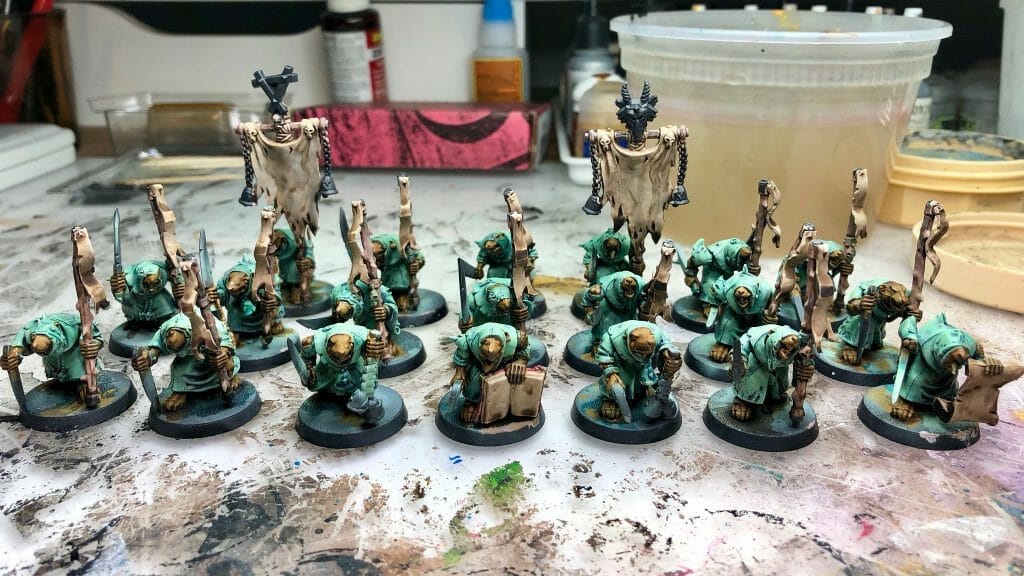
Why Paint Miniatures Faster?
No, seriously. It’s a good question. Painting miniatures is an art, isn’t it? So, it should be methodical and carefully done. You want the best results for the public to see….Well, certainly for a lot of new painters, getting models painted is a main goal.
But, I’ll also venture to guess that many miniature painters want to also feel that sense of accomplishment of completing a miniature. The sooner, the better.
Or, maybe your aspirations aren’t that lofty. You’re a gamer first, a hobbyist a far second. In this case, getting your models painted quickly to a tabletop standard is your goal so you can get right to what’s most fun to you—playing the dang game.
MORE: SPEED PAINTING TIPS AND TRICKS FROM A COMMISSIONED PAINTER
Does Talent Matter Anymore?
Look, it happens all the time. We compare ourselves to our peers. Whether we like it or not, we make value judgements. Although painting miniatures is an art, and ‘beauty is in the eye of the beholder’ and all that—it is also true that there are people who fall into two extreme camps: the divine talented and the mere mortals, who wield a brush like a toddler holding a crayon. I’m guessing that most of us fall in between these two groups.
Citadel Contrast Paints are meant to level the playing field for miniature painters across a wide spectrum of skill and motivation.
What is universal across all miniature painters (and hobby-gamers) is the desire to have fun. And, playing or collecting miniatures with paint on them is way more fun.
MORE: HOW TO STAY MOTIVATED TO FINISH PAINTING YOUR MINIATURES
Ultimately, painting talent—also known as that indescribable ‘magic’ that allows some people to paint amazingly without effort—is only one key to a miniature fully painted to a satisfying quality. It takes hard work, dedication, and a few good tools (e.g., brushes, paints).
Well, the Citadel Contrast Paints should be one more tool in your toolbox to help you get work done faster. And, if Citadel Contrast Paints are anything, they are a cute bundle of your inherent talent, skill, and motivation effort in a single paint pot—just apply in “…one thick coat”.

What Exactly are Citadel Contrast Paints?
Contrast paints are a new formulation of paints made by Game Workshop. They are designed to be applied over a bright undercoat (recommended as white colored). If I was to simply describe the behavior of Citadel Contrast Paint, it would that it is a highly-pigmented paint suspended in a medium that helps it act as both a wash and glaze at the same time.
“How to use Citadel Contrast Paints”
They two key mechanisms for the Citadel Contrast Paints is straightforward and binary:
- Like a wash: When Citadel Contrast Paints are applied thickly, essentially soaking a brush, the viscosity and surface tension of the paint tends to allow most of the colored pigments to settle in deeper recesses—like a wash. This behavior pulls out details, darkening appropriately, and keeping the raised surfaced brighter (since your bright, white undercoat will show through). The Citadel Paint
- Like a glaze: Because Citadel Contrast Paint is transparent for the most part, but has high density of pigments in it, the paint can work like a glaze. A glaze is a medium and approach whereby paint applied to a surface doesn’t fully obscure colors and values below. In this manner, a glaze merely changes the color and tone of the surface upon which it is applied. Citadel Contrast Paints act just like this on the raised surfaces of the model.
If you understand these two deconstructed aspects of the Citadel Contrast Paints, then you will quickly realize how useful this is. For example, in my personal painting projects, I have painted many miniatures quickly by using washes and glazes—and often I use washes and glazes in-combination.
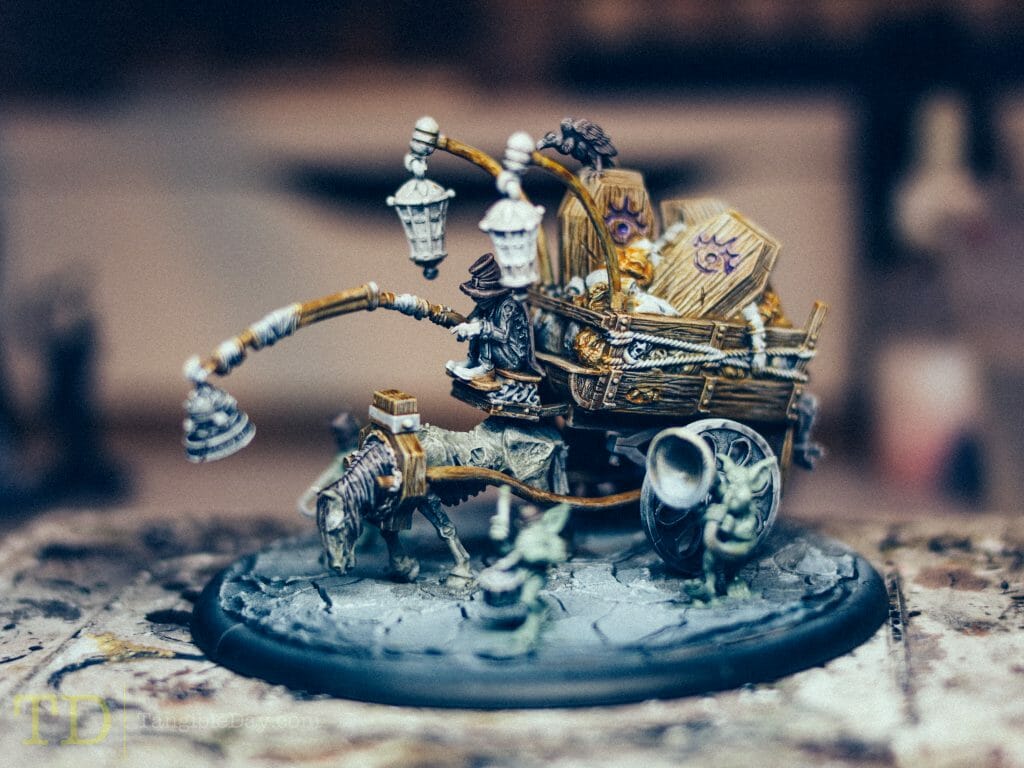
With a bright undercoat, a miniature painted in this fashion can be rapidly painted to a relatively high tabletop standard. This takes practice, of course, and a bit of experimentation to know how to make the ‘right’ ratio of paint to artistic mediums. Painting an entire miniature entirely with washes and glazes takes some skill, but can yield great results.

Most of the time you can make your own washes and glazes by mixing in the appropriate artist mediums, such as flow aid improvers, clear acrylic mediums, glaze mediums, or brush-on varnishes.

Although a true do-it-yourself (DIY) alternative version of Citadel Contrast Paints has yet to emerge from the miniature painting community—we have described a few starting points for coming up with a good formula for making a home-made version of Contrast Paint. I’m sure that when I or someone else finds a good ratio, it will likely include some amount of the artist mediums I list here. Read on for more thoughts on making your own alternative Citadel Contrast Paints.
The use of Citadel Contrast Paints is likely similar to many homemade washes and glazes, but Citadel has created something that takes the guesswork out of these traditional approaches many professional painters have used for years.
What Colors are in the Citadel Contrast Paint Range?
There currently isn’t a paint bundle for Citadel Contrast Paints. However, there is a very large selection of paint colors in the Citadel Contrast Paint line that I’m sure you’ll find useful. There are 34 colors in the Citadel Contrast Paint range. All of them seem to work well alongside existing Citadel Base, Layer, and Technical paints. So if you’re more of an advanced painter, then with some experimentation these paints could come in handy as accent colors or for additional special effects. The miniature painting world is your oyster.
Here are the 34 colors in the Citadel Contrast Paint line:
- Iyanden Yellow
- Blood Angels Red
- Volupus Pink
- Magos Purple
- Akhelian Green
- Gryph-hound Orange
- Flesh Tearers Red
- Shyish Purple
- Leviadon Blue
- Dark Angels Green
- Nazdreg Yellow
- Creed Camo
- Aggaros Dunes
- Snakebite Leather
- Cygor Brown
- Ork Flesh
- Militarium Green
- Skeleton Horde
- Gore-grunts Fur
- Wyldwood
- Fyreslayer Flesh
- Darkoath Flesh
- Space Wolves Grey
- Black Templar
- Warp Lightning
- Guilliman Flesh
- Gryph-charger Grey
- Basilicanum Grey
- Talassar Blue
- Aethermatic Blue
- Plaguebearer Flesh
- Ultramarine Blue
- Terradon Turquoise
- Apothecary White
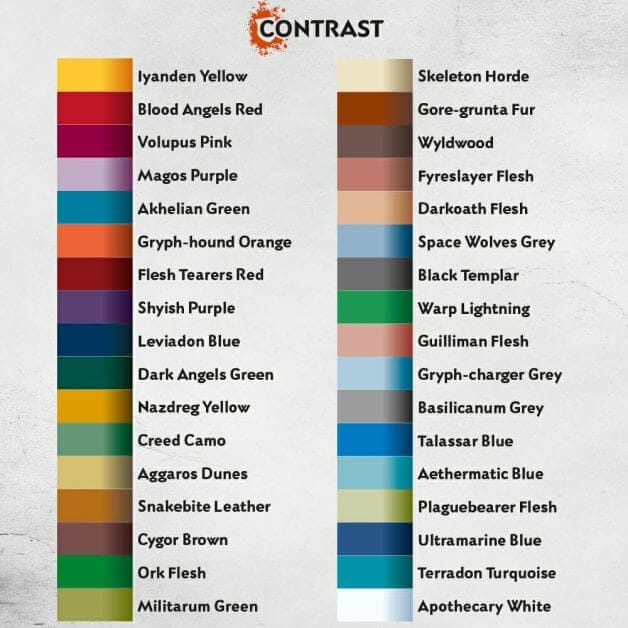
In comparison with other Citadel ‘regular’ paints, or other miniature paint ranges, e.g., Vallejo game colors, Master Reaper Series, or P3 Paints, the selection of Contrast Paint is quite narrow. Also, in terms of comparing the Citadel Contrast Paints with conventional miniature paints is kind of a futile endeavor. They aren’t designed with the same mechanics in mind.
As mentioned, Contrast Paints work neither as a regular paint, or function as a singular effect paint, such as a pure wash or a glaze. Instead, Citadel Contrast Paints operate somewhere in between, as a mixture of different attributes designed to add colors and contrast quickly at the expensive of solid coverage and the ability to apply even coats (e.g., Citadel Contrast Paint don’t work well over large smooth surfaces—areas with detail and texture are where the Contrast Paint excel).
The nice thing about the Citadel Contrast Paint range, however, is that the colors appear to be strategically chosen to replicate the major army faction color schemes you would see in the studio photographs. Furthermore, because they are made within the Citadel ‘ecosystem’ the built-in color theory with these colors allows them to harmonize with the existing Citadel paint range. So, mix-and-match! … or not. Apply with one thick coat, as first intended.
Fantastic!
Can You Airbrush Citadel Contrast Paints?
Yes, you can! See here for an example of using Citadel Contrast Paints through an airbrush. Apparently, it works really well as an airbrush ready paint.
“The Contrast paints work so well through the airbrush—“ says Andy Wardle, winner of multiple Slayer Sword painting awards. “[Citadel Contrast Paints] need no dilution and are so easy to clean up after as well.”
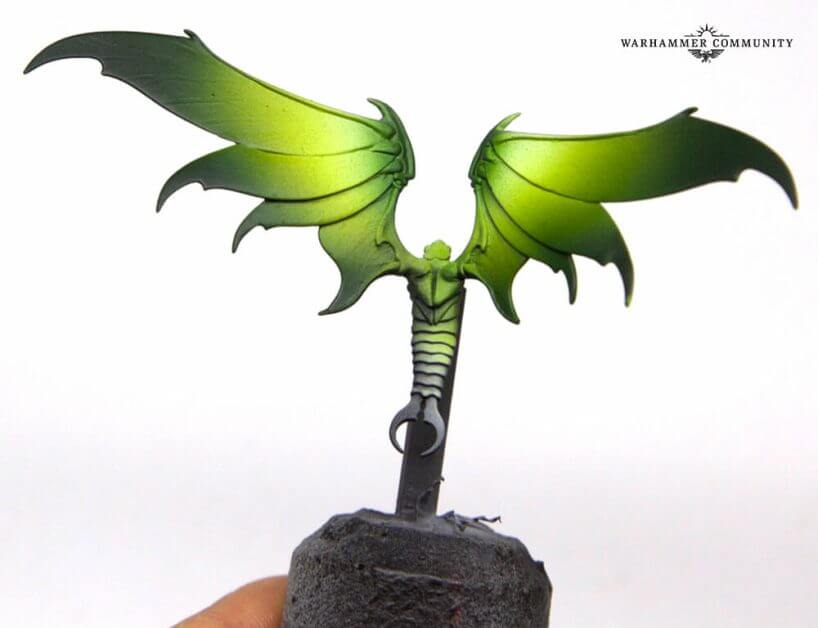
One of the problems with using regular paints, especially Citadel layer or base paints is that they are too thick. If you’re using a standard gravity feed airbrush with a 0.3mm nozzle, any of these regular paints will need to be thinned (usually with water or airbrush flow improver, which I tend to use most often).
Because Citadel Contrast Paints are thinner (acting as a wash or glaze), they don’t require any thinning for proper airbrushing. Even less guesswork for someone who wants to use their airbrush with these new colors. Good news all around for those aspiring to use these Citadel Contrast Paints, especially now that glazing with an airbrush is all the rage. See Sergio Calvo Miniatures—where Sergio uses an airbrush to glaze and accent his awesome paint jobs.
Do I Need a Varnish for Citadel Contrast Paints?
A varnish is a clear covering you either brush, airbrush, or spray (aerosol) over a miniature to protect the paint job. Models painted with Citadel Contrast Paints are no exception. In fact, Citadel Contrast Paints are quite fragile because they dry thinly over the raised surfaces of a model. Moreover, despite applying Contrast Paints with a thick layer, when the paint dries, there is actually very little pigment and binding medium over most of the surface.
This is the double-edge sword of Citadel Contrast Paints. They are advantageous because of their thick application, but thin and transparent finish. But, this makes them vulnerable to scratching and peeling because the layering is so thin.
In my opinion, 3-4 layers of a high-quality varnish will be needed for any miniature painted with Citadel Contrast Paints. I would highly-recommend using Testors Dullcote spray enamel. It is fairly inexpensive, easy to apply, and protects models in the hardest/most durable varnish you can use inside your home (with some exceptions like good ventilation). Another reason to varnish with a matte coating is to ensure a consistent finish. Removing reflective ‘hotspots’ will help you retain that high contrast and color pop that you’re looking for in a nicely painted miniature.
Pro-tip: Make sure you use Testors Dullcote in an environment with less than 55% humidity to ensure it doesn’t frost over.
The best solution I have for varnishing safely without adverse ‘frosting’ is to use a hairdryer. See my article on why you need a hair dryer for painting miniatures. Do a simple Google search on the horror stories of frosted miniatures with spray varnishes. In either case, varnishing your models after painting them with Citadel Contrast Paints is certainly recommended!
What is the Best Citadel Contrast Paint Color?
This line of questioning actually came up in a discussion with some other miniature painters. Really, the easiest answer is “there isn’t a best Contrast Paint color”, or “what do you mean ‘best’?”, or “it depends on what you want to paint.”
Personally, I think the question is silly. But, if I had to choose a single color that I would recommend anyone to pick up first, it would be Guilliman Flesh.
The reason I choose Guilliman Flesh as my recommended first Contrast Paint color is because painting faces is one of the hardest things to get right.
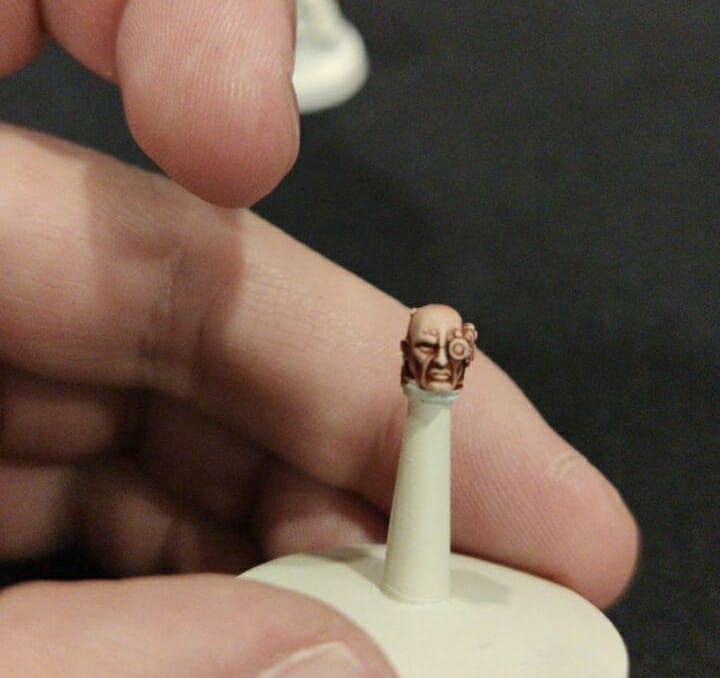
Making the blends and highlights for a convincing good-looking miniature face is really challenging using traditional methods. With Citadel Contrast Paints all you need to do is apply one thick coat (relatively speaking), and let it dry as you would a wash. And, ta-da, most of the work is done for you.
Also, flesh tones in general are pretty hard to do. So, if you have some fleshy miniatures, Guilliman Flesh Contrast Paint will help you out immensely. If you’re a bit more advanced, you can glaze over the Guilliman Flesh color to add additional tones and accents.
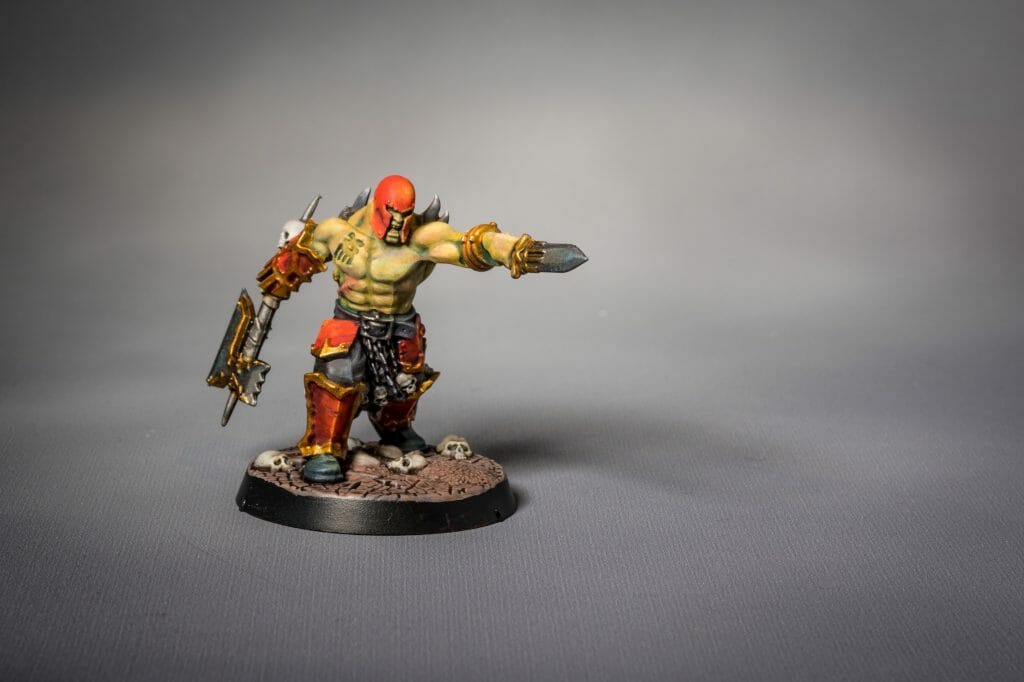
What About a Second Contrast Color Recommendation?
Yellow! Absolutely, the worst color to paint in my opinion. Generally, yellow paints have poor coverage and don’t produce an even coat without several (read that as “many”) layers.
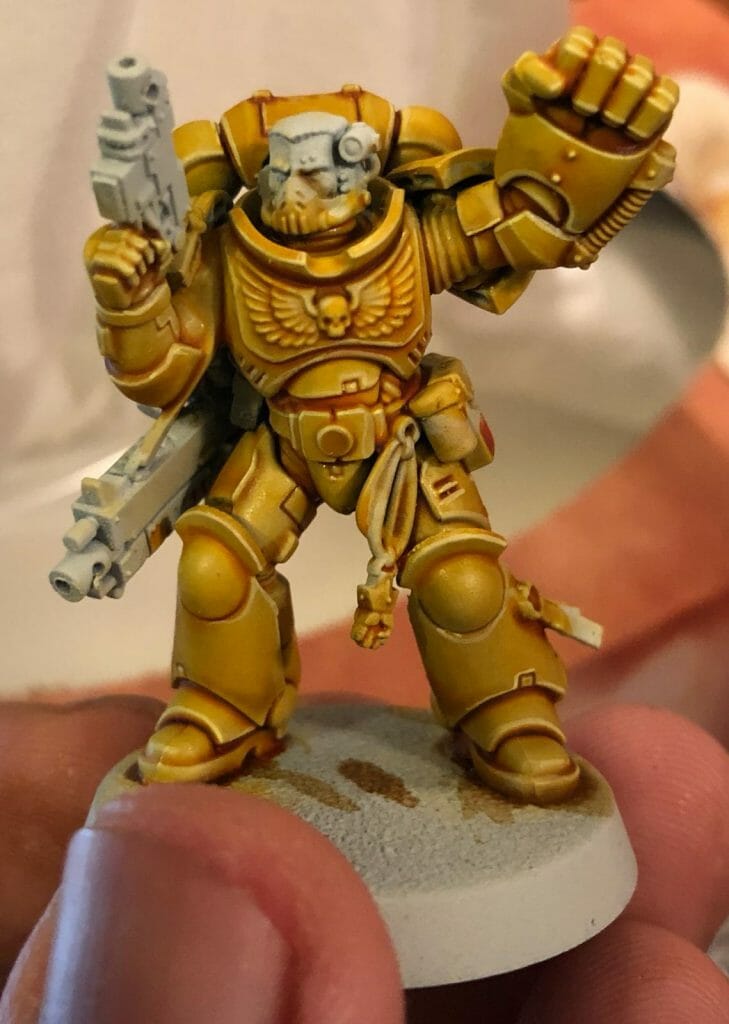
But, I think with Citadel Contrast Color, if you’re looking to get yellow painted quickly and easily, I’d give Iyanden Yellow CNN a good shot.
Why? As I mentioned, painting yellow is hard and frustrating. I have a fairly large 40k Imperial Fist army that has yellow as it’s primary color scheme. For the most part, I have to airbrush my yellow paints to get good even coverage. And, even with an airbrush it takes a long time. Not only is Citadel Contrast Paint designed so it is readily airbrushed (it has a thin viscosity), it has excellent pigment density. That means it takes less work to get a model to look…well yellow.
Finally, yellow isn’t the easiest to shade. Given that you can use a wide variety of darkening colors and values to add contrast to traditional yellow, the challenge is knowing which of these options is the optimal one. Forget all that with Contrast Paints. Just apply it, and let the color theorists at Games Workshop solve that calculation for you.
How Do You Thin Citadel Contrast Paints?
It doesn’t seem like you need to thin Citadel Contrast Paints for them to work as intended. But, if you did feel the need to do some mixing or blending, Games Workshop makes a specialized Contrast Medium to help you thin the Contrast Paint range.
I’m not 100% what is in this medium for thinning Contrast Paints, except that it’s probably some kind of proprietary artist mixing medium. A
s such, I’m sure an ingenious miniature painter and chemical hobbyist could figure out a cheaper, but as-effective alternative to the Contrast Medium sold by Games Workshop. I will at some point learn this secret and post an article about my findings.
MORE: GREAT ALTERNATIVES TO CITADEL TEXTURE PAINTS
For now, I suppose if you wanted to have the least hassle when it comes to thinning your Contrast Paint, the Contrast Medium would be the way to go!
What is the General Impression?
“Good and bad,” according to Chris Spotts at the The Spotted Painter. It’s worth playing around with Citadel Contrast Paints in specific circumstances. But, in general, you can make your own contrast paint alternatives without the expense—as mentioned above—there is some painting knowledge required to make your own wash and glazes.
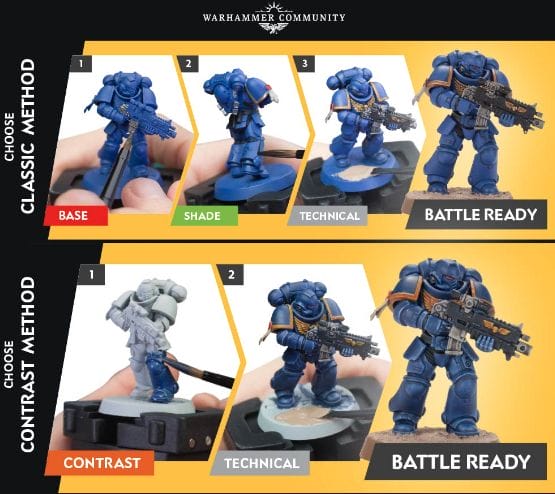
The Good
- High-density acrylic pigment – Contrast Paints are much more pigmented than an average wash.
- Army-sized painting – If you have a lot of models to paint, for an army for example, you can paint specific parts very quickly. For example, all the orc flesh (see the image below).
- Glazing – Contrast Paints work absolutely fantastic as glazes.
- Wet-blending advanced techniques – Wet blending technique works well for color blending. But, this can become difficult without getting the Contrast Medium (mentioned above). Wet blending different colors without thinning the Contrast paints results in a loss of contrast—presumably because pigment builds up quickly—and you lose the gradient of brightness value that is the prerequisite for maintaining contrast.
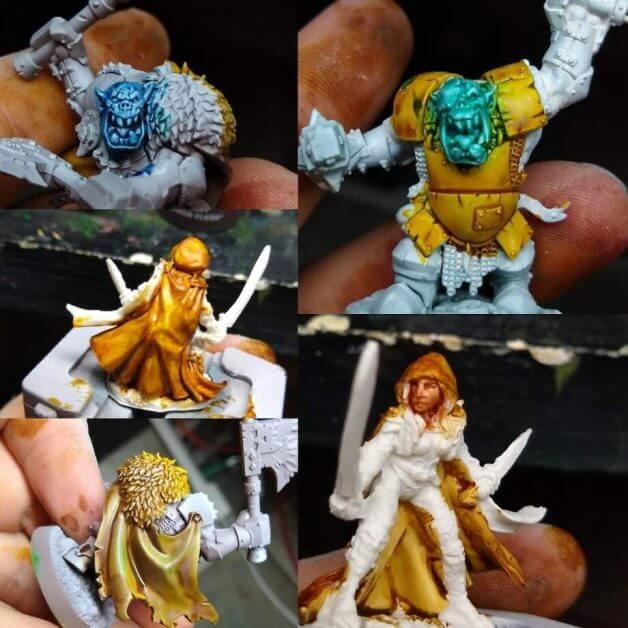
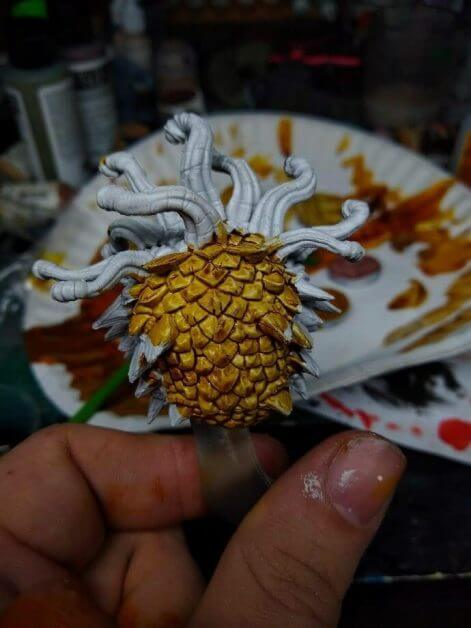
The Bad
- Limited advanced technique application – If you’re aiming to do more advanced painting techniques, you will have to learn the nuances of how the paint behaves on a model. Contrast Paints don’t act like traditional miniature paints, washes or glazes.
- Prone to sloppiness – You need to be very careful as you apply Contrast Paint. Unfortunately, it can be difficult to very careful. This is the Catch-22 of Citadel Contrast Paints. For it to “do its thing”, Contrast Paint needs to be applied heavily. But, when you apply Contrast Paint in this manner, you can easily lose control of where the paint flows. It can seep into unintended areas. This is problematic because Contrast Paint is semi-transparent. If it goes into an area that you don’t want a certain color, the previous color will show through. In other words, it is difficult to fix errors with Contrast Paint. You’ll basically need to constantly touch up with the original primer, or be very careful with where you place the Contrast Paint. This retards much of the marketed “speed”. Of course, how much of a concern this is, depends on the model. Model sculpts with highly defined elements may be easier to paint, because Contrast Paint won’t flow unimpeded into different areas.
- Effectiveness depends on model – The “contrast” you achieve is highly variable with the details of the specific model. If you look at the orc faces, they have decent contrast because the paint flows away from the raised surfaces, e.g., cheek bones. The contrast on the Beholder scales (i.e., the scaled-floating monster with tentacles) is, however, pretty mediocre. For certain models, you can get a better contrast effect with traditional dry brushing techniques.
- Slow drying – Be prepared to wait. Contrast Paint takes awhile to dry. And, the paint may even look dry, but will peel easily if you’re not patient enough — I’ve mentioned the use of a hairdryer as a useful tool to speed up this process.
- Low utility on large flat surfaces – Contrast Paint is less predictable on flat surfaces. Most of the time the paint will leave various uneven stains. You can play with the Contrast Paint as it’s applied to some extent to reduce ‘pooling’. But, even for me as an experienced painter, this can be quite difficult. Contrast Paints do work better on flat vertical surfaces, such as the orc front plate, for example. You can compare this to the ‘staining-effect’ on the orc shoulder plate.
- Fragile coating – Contrast Paint is incredibly fragile. You will need good primer and a good coat of varnish afterwards. The high points will rub off easily — see above about varnishing with Testors Dullcote spray.
- Risk for spilling pots – You’ll be painting with the pot open a lot ….so prepare for spills! (We have an article lamenting about this problem here). Either transfer Contrast Paints to larger than normal (18 ml) bottle, sticky tack the paint pot down, or get an anti-tip bottle holder. But, don’t be surprised if you spill your Contrast Paint if you don’t take precautions to reduce the risk.
- May limit style – Contrast Paints have a pastel, brightness to them. Ultimately, paint jobs that exclusively use Contrast Paint will have a certain look that everyone else painting with the paint range will share in a stylistic way.
- Works best only on high quality, detailed models – You don’t need to use Citadel Contrast Paints on just Citadel/Games Workshop models. Contrast Paints can work work on Reaper Bones miniatures (kinda). Reaper miniatures generally have softer details in the sculpt, which makes Contrast Paint less effective for creating and maintaining a high contrast paint job. For example, see the face of the Ranger in the image above.
What If You Wanted To Make an Alternative ‘Contrast Paint’?
Let’s say you wanted to try and make your own ‘Contrast Paint’.
You can get very close to the same effect with Army Painter Quickshade Wash Medium, high quality ink, and flow improver. The Beholder scales (image below) were painted half with Citadel Contrast Paints and half with a DIY mixture. Here, it is difficult to tell which side was painted with what paints. Although an actual recipe is in-development, there is a good starting point to start experimenting.
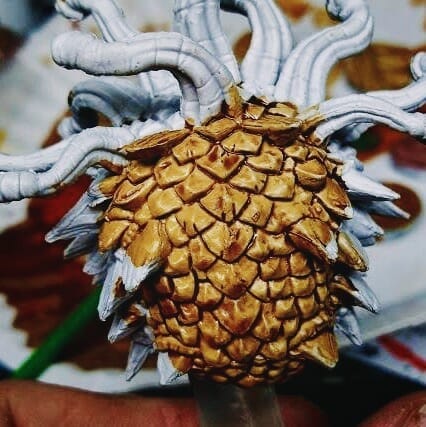
For a starting point toward making your own DIY “Contrast Paints” that is nearly identical and much cheaper than Citadel’s version start with approximately 8 parts mixing medium (any brand, or use list below), 3-4 parts highly-pigmented ink (of any preferred color), and 2 parts flow aid/improver.
- Army Painter Quickshade Medium (8 parts)
- Scale 75 inktensity (3-4 parts)
- Winsor Newton flow improver (2 parts)
Mix these colors in a glazed ceramic palette. Thin with water to a preferred viscosity and apply to a model primed with a bright primer (preferably white or light gray color) as a fairly heavy coat. Let your mixture pool in the recesses and keep it from dripping into unwanted areas. Hopefully, with some extra playtime, you’ll discover that you’ve created contrast without using real ‘Citadel Contrast Paints’.
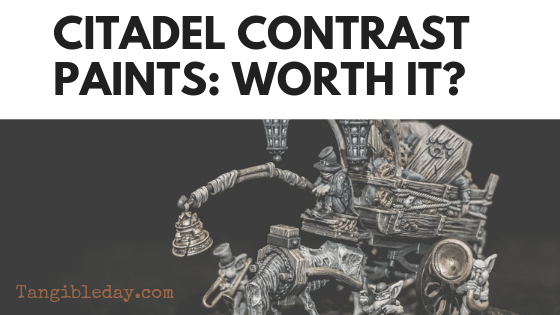
Are Citadel Contrast Paints Worth It?
- For the new painter or gamer who wants to get a model fully-painted quickly to a tabletop standard, Citadel Contrast Paints are highly-recommended.
- For the advanced painter, Citadel Contrast Paints maybe worth it for the same reason as above (speed painting), but could also be useful as an additional tool for getting contrast on more difficult areas of the model painted.
- Citadel Contrast Paints are particularly useful for painting flesh tones and traditionally hard-to-use colors, such as yellow or orange.
- Citadel Contrast Paints could have strong utility for getting the faces painted on miniatures; specifically by allowing the painter to easily maintain facial contours with the proper highlights and shading through a quick overcoat.
- Citadel Contrast Paints are more useful on models with a lot of distinct details in the 3D sculpt; less useful for models with less detail and models with a lot of flat surfaces.
- Citadel Contrast Paints come in the iconic Game Workshop paint pot/bottle, which are prone to spilling. This is especially true for the taller bottles (18ml or greater).
- Citadel Contrast Paints are priced at about $10 USD, which places them on par with the rest of the Games Workshop paint range cost on a per volume basis. Given that Contrast Paints are meant to be applied in a much heavier coat, however, using Contrast Paints exclusively over many models will be more expensive than using regular Citadel Paints, or those paint lines from Games Workshop competitors.
Examples for how Citadel Contrast Color looks on models with different spray primers:
Source for images
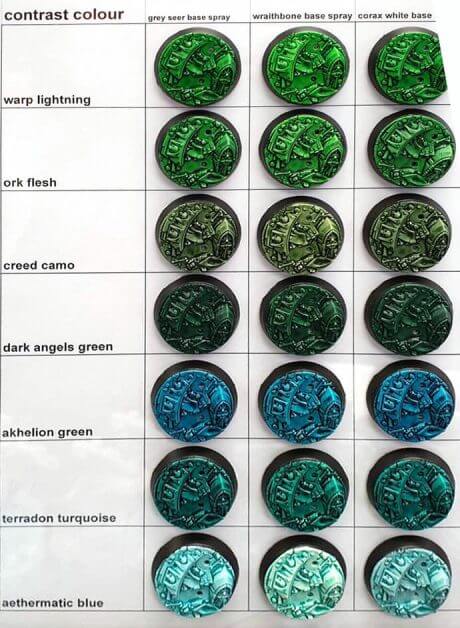
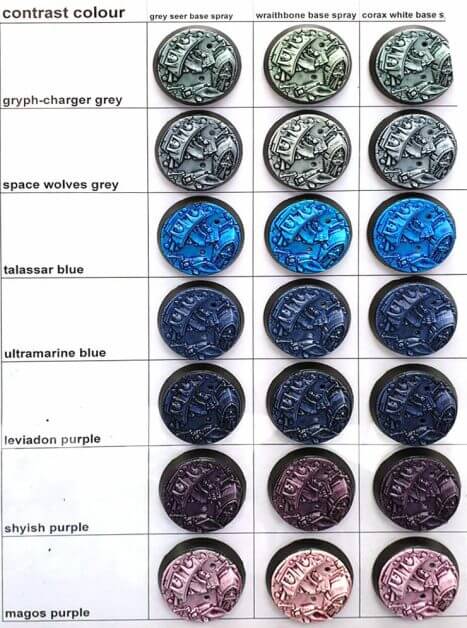
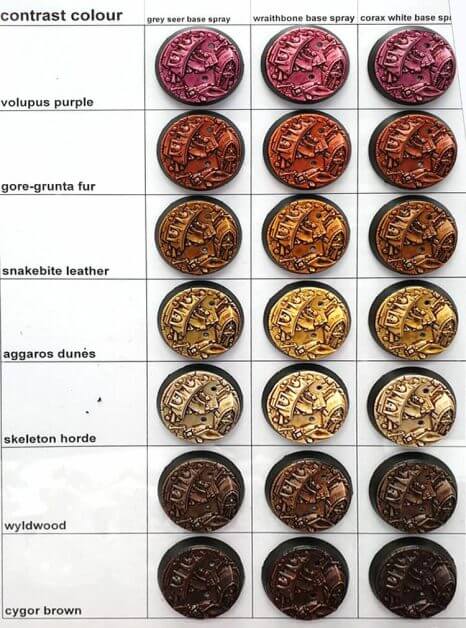


Best alternative primer for Citadel Contrast Color Paint?
The typical primer that Games Workshop suggests that you use is their Grey Seer Spray Primer. The look you get with Citadel Contrast Color paint using this spray primer is optimized for Warhammer plastic miniatures.
You will get the most accurate representation to the normal Citadel Paint line when you use the Grey Seer Spray Primer in conjunction with the Citadel Contrast Color Paints.
As an alternative primer for using Citadel Contrast Colour Paint, I highly recommend using Vallejo’s Surface Primer (the Grey or White color). This will provide you with the best foundation for painting with Citadel Contrast Colors.
RELATED: TOP 10 PRIMERS FOR PAINTING MINIATURES AND MODELS
The best way to apply the Vallejo Surface Primer is with an airbrush. But, if don’t have an airbrush, that’s okay. Just make sure you apply the primer in thin layers. See this guide on best practice using primers.
You want to make sure the primer is applied smoothly and evenly. This will produce the best results with the application of Citadel Contrast Color paints.
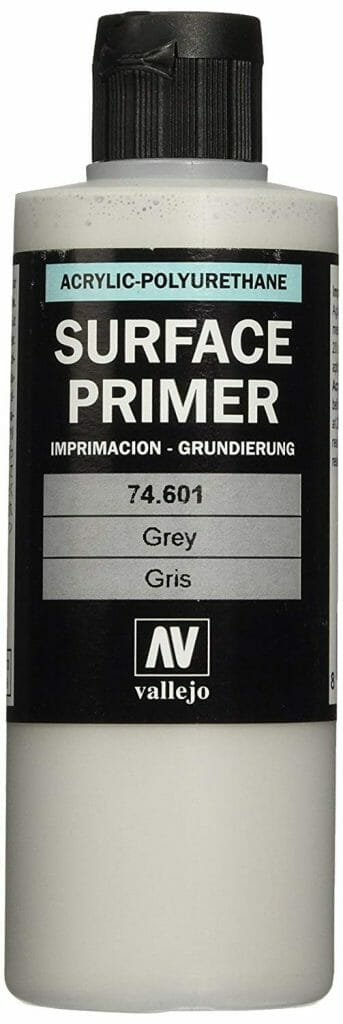
Here’s what Citadel Contrast Color looks like using an Alternative Surface Primer from Vallejo:

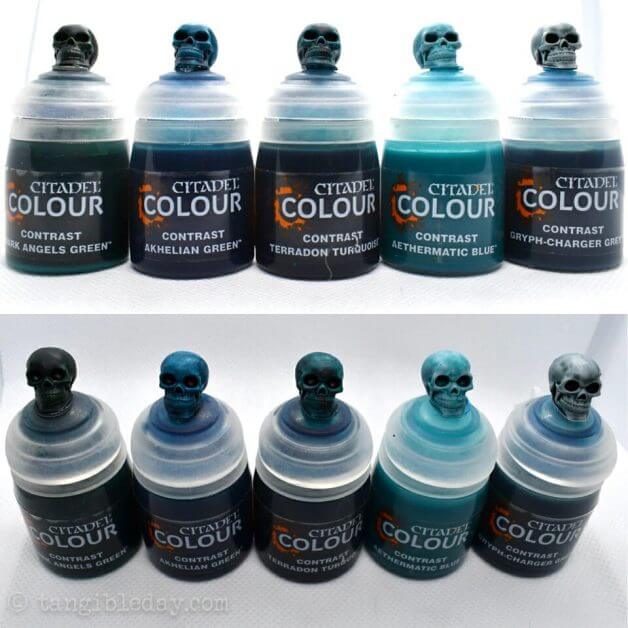

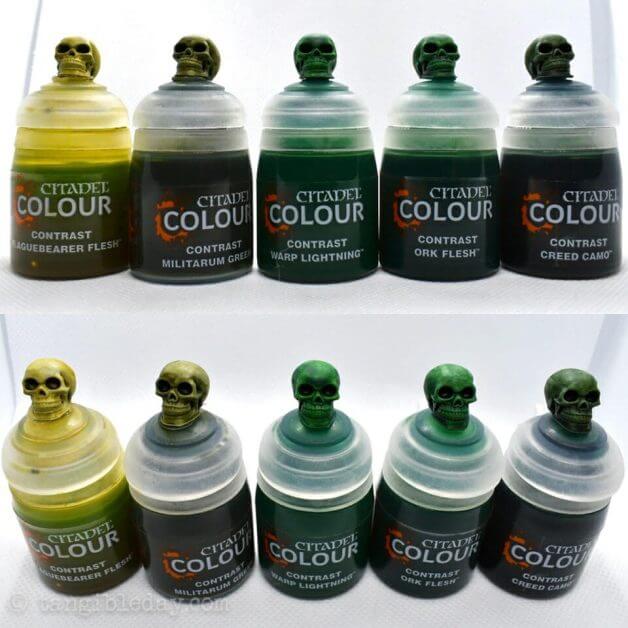

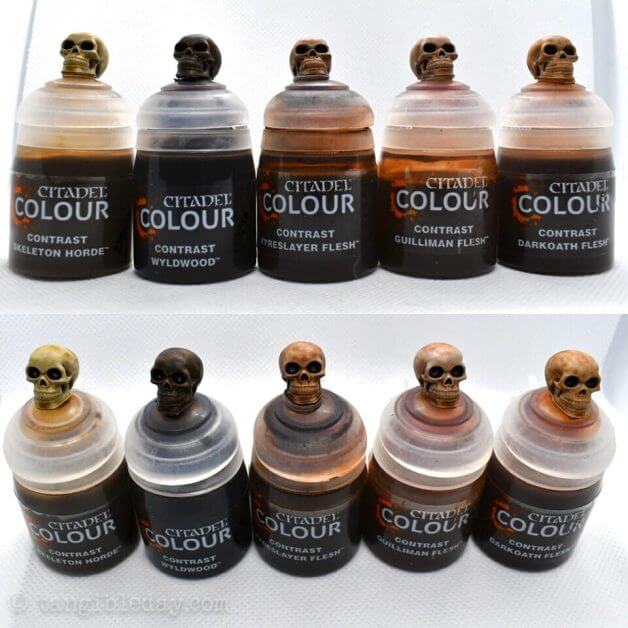


Final Thoughts
I personally think that the Citadel Contrast Paint range is an awesome addition to any miniature painters’ toolbox.
I’m particularly keen on using the flesh tones and yellow colors for my particular miniature collection.
Contrast Paint will help speed up my work and help me keep a consistent look on the parts of the models that pose the biggest challenge for me (e.g., bare flesh, skin, and yellow-colored armor plates).
I have a feeling that Citadel Contrast Paints will also come in handy for me when I dive deeper into painting more organic-miniatures.
In this review, I say the Citadel Contrast Color Paints are totally worth it for those of us who want to paint faster and have fun doing it.




Tangible Day on YouTube (Miniatures and More!)

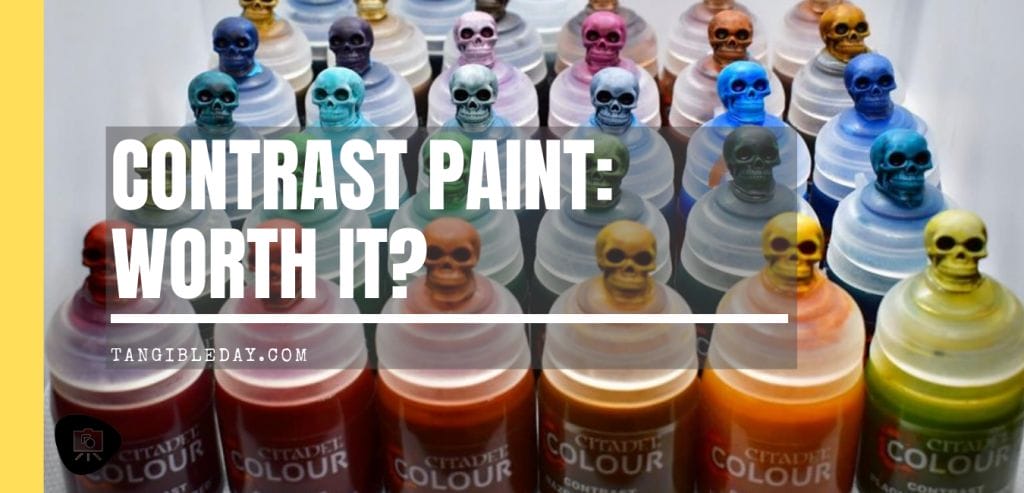
It’s funny you should mention the flesh tone as I have recently started undercoating flesh tones white then using multiple layers of flesh wash to get to where I wanted it to be. I might give the contrast paint a bash for the skin colours. Last night I painted up some arachnids using Army Painter green wash…I could have waited and tried the green contrast paint, but this way proved quicker and cheaper 😉
Cool. Yeah, Contrast Paints are relatively expensive. I should have just come out and said it. But the flip side is that they are convenient! I’ve got a good routine with my workflow now, but will definitely try these out to get around some harder corners. 🙂
Fantastic and thourough review, thank you. I am an average painter, having little time, and tons of figs of Conan, Zombicide, Descent, Deep Madness…..waiting in the box…. this could be my life saver.
Excellent! Give the paint a shot and let me know how they work out for you 🙂
LOVE the skulls on top of the pots! I’m a newb painter and LOVE the contrast line…I would add snakebite leather as a top choice. It just makes those satchels/belts/quivers look so good! Are those skulls from something? I want to steal that idea!
The skulls are 3D printed 🙂 – you can find them on thingiverse. Yeah, contrast paints are pretty awesome, especially if you want to get paint on your models quickly with nice results. Yeah, the snakebite leather is nice too. I’ve started learning how to mix colors to switch things up a little. Btw, the other way you can test the colors without those skulls is to use little pebbles or rocks. They give you a nice surface with enough variation texture to see what the ultimate contrast color will look like. Thank you for reading!
LOL i hadnt seen that “finally one thick coat” ad before. Maybe Duncan quit in disgust 😀
He had great videos! Lol
Hi there, thanks for the review. I’m just getting back into miniatures after a long long break. These paints look just the ticket for me as I’ve never been the best painter of minis plus as a father of a 6yr old I don’t have oodles of time. Can I ask, how well do the Contrast paints go onto metal miniatures? I’ve picked up some old Rogue Trader terminators and would like to paint them with the contrast range BUT I haven’t seen any comments regarding if they work ok with them? Cheers.
Hi, I appreciate the comment! Absolutely, these paints can help you totally get started again and get really nice results, quickly. Yes, the Citadel Contrast paints will work great on any miniature, plastic, metal, or resin. This includes your old Rogue Trader Terminators. Just make sure you prime your miniature with a good primer (check out this post – https://tangibleday.com/top-10-primers-for-plastic-and-metal-miniatures-reviews-and-tips/). Btw, I’m also a dad of young kids, too. I barely keep my head above water 😛
Let me know if you have other questions and please do share with me anything you do! The link to Facebook and Instagram are above in the article. I love seeing painted minis 🙂
Hey there. Wonderful article, as a someone just getting into miniatures it was eye opening. I’ve been using army paints shaders and plain inks, without mixing with anything, to add contrast, and it works, but sometimes it works like opening a can with a hammer also works.
Thanks for the article, I have to try this now.
By the way, what is the miniature of the wagon with the coffins from? Your final result on it is amazing.
I appreciate your comment! And I’m really happy your found this helpful 🙂 – Citadel comes out with cool stuff pretty often. Let me know how it goes with your models. The one with the wagon and coffins is from Privateer Press and the model is “The Death Knell” (Grymkin line).
Probably not the feedback you’re looking for, but I found your review to be pretty fair when it comes to model purposes. Outside of that, seemed a little unfair. Contrast paints will go on surfaces I can’t get other paints to stick to like things treated to be water resistant, and then I can continue painting as normal over the contrast bath. I find them to remain very vibrant over time outside of their intended purpose as well and use them in many 3d projects. Goes on wood. Goes on a variety of surfaces. Huge fan on the line. I’ve used a lot of different kinds of paints and pigments over the years and these are my favorites by far.
Thank you for the comment! Yes my experience is solely on models. I will have to take a closer look and experiment on other surface types to comment further. I do enjoy using contrast paints. Do you use them for traditional artwork?
I’d love to tell you I’ve tried them on a canvas already, but not yet. I did a lot of sculpting when I was younger so I knew right away it was kind of like a wash/glaze when I saw my husband trying to figure it out. I bought so many. He was like, “are these really that amazing?”
I do all kinds of projects with them like making masks, and painting like jewelry boxes and stuff. Really anything I can. I can say it works well over typical craft store acrylic paints. So if you put a base of acrylic on a canvas that would definitely work. Could make some nice skies or something with it. Possibilities are probably endless. One of my favorite projects I used it for was a base color for a Deku mask for Deku Link from Legend of Zelda: Majora’s Mask. It’s so sad because it looked so good, and I covered it up with bark bits so you wouldn’t even see it much. You’d notice all the white of the mask base if it wasn’t there, though. I started with a plain brown acrylic paint and then added a green contrast on top and it was fantastic. Immediately looked like something of the earth. I took in progress pictures I use to show people in crafting groups how contrast paints add depth to a project. What makes it really useful is that it kinda soaks in as well which you will not find much as an option for washes and glazes, and it has a great consistency in results. I’ve used inks and stuff like that before. Contrast is just really reliable, and I don’t have to mix it myself.
Do you a site? I’d love to see your work 🙂
If you want to contact me (link below), maybe we could show some of your work here too.
Great read! Wandering if you have changed your DIY recipe for contrast paint over the last couple of years.
Nope. It’s still the same ! I still use them mostly for hard colors to paint like black or yellow 🙂
Well that is “IYANDEN”. 🙂
Great article though!
Lol fixed 😉 and thanks !!!